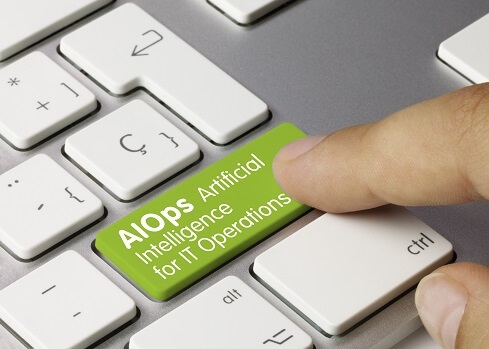
Network and infrastructure management has always been complicated. AIOps promises to simplify things.
As networks and data center infrastructures grow ever more powerful, management is becoming increasingly complicated and challenging. But perhaps not for much longer.
Artificial intelligence for IT operations (AIOps) promises to make life much easier for data center teams by enhancing operations with analytics and machine learning (ML) technologies. AIOps platforms work their magic by leveraging big data, collecting a variety of data from various IT operations tools and devices in order to automatically spot and react to issues in real-time. As AIOps continues to prove its value, its popularity is growing. Gartner recently predicted that by 2023 up to 40% of DevOps teams will augment their application and infrastructure monitoring tools with AIOps.
Pressure Relief
At AIOps’s heart lies the ability to analyze alerts and events while providing automated operational responses aimed at maintaining the health, uptime, and performance of IT services and solutions. “AIOps helps to identify false positive alerts, corelate ecosystem wide notifications, and predict and prevent outages before they occur,” explained Ross Ackerman, head of customer service data science and enablement at hybrid cloud data services and data management firm NetApp. “AIOps capabilities are most often seen in the form of predictive analytics with automated proactive action, identifying and avoiding issues before they happen to services or entire solutions,” he added.
In complex environments, automation typically requires integrating multiple IT systems. “AIOps can be one way to infuse more visibility and stability improvements into workloads,” said Rajiv Mirani, CTO at hybrid cloud platform provider Nutanix. “AIOps analyzes data at scale and delivers insights that infrastructure and operations teams can then act on,” he noted.
IT leaders are under considerable pressure to beef up digital capabilities and performance to deliver on their organization’s digital transformation agenda, observed Prasanna Velayudham, IT transformation director for application management at IT and business advisory firm Capgemini North America. “With rising demand to assure speed to market without compromising on system health and availability, IT leaders are left with no option but advanced analytics and end-to-end automation,” he said. “The primary need is to leverage advanced data analytics and automation to achieve proactive and predictive problem identification and remediations for enhanced system performance.” Combining capabilities to understand and guide customer journeys with AIOps will enable IT to outperform expectations, he stated.
Multiple Benefits
IT teams are drowning in pools and lakes of network and system events, alerts, and notifications, thanks to a rapidly growing number of network and system monitoring and alerting tools. Nearly 25% of large enterprises now have eight or more monitoring tools installed to provide a holistic overview, Ackerman noted. “With multiple tools comes multiple unconnected alerts and events for IT support staff to track down and respond to,” he observed.
AIOps offers organizations the potential to improve IT team productivity and cost while fortifying overall business stability and resilience. The technology also supplies the ability to gain deep insights on customer experiences and journeys. “AIOps can bring predictive abilities to operations so organizations are able to adjust to changes,” Velayudham said. “By automating the mundane work and uncovering insights from large datasets that aren’t possible to sift through manually, AIOps can increase IT team efficiency,” he added.
By taking a strategic and intelligent approach to IT automation, businesses can also accelerate their digital transformation efforts. “IT automation can also eliminate repetitive manual tasks, freeing up your IT team to address more strategic tasks, making the entire team more valuable to the business,” Mirani said.
Getting Started
The AIOps vendor field is growing rapidly. This fact should help ease AIOps adoption, but it’s also creating some confusion for potential customers as they find themselves sorting through various tools and approaches. Another challenge facing potential adopters is dealing with the quality of various types of collected data, such as the logs and metrics generated by legacy applications, as well as tapping into the collective knowledge of all that data. “Transitioning to enterprise AIOps is not going to be a quick victory for many enterprises,” Velayudham warned.
To get started with AIOps, Mirani advised educating teams and getting them up to speed on the latest AI and ML capabilities. “Don’t try to cut corners on training; educating your team is critical to getting everyone on the same page,” he said.
Mirani noted that he’s found it most effective to tackle initial projects one at a time. “An analysis of which tasks or workloads take the most resources and time can help to prioritize your AIOps efforts,” he said. “When you tackle the bigger, more complex projects one by one, your team will already have best practices in place that can help streamline your overall strategy.”
Related Content:
How CarParts.com Leveraged AIOps Strategy While Scaling Up
AIOps, DevSecOps, and Beyond: Exploring New Facets of DevOps
IBM Talks AIOps Potential at Digital Developer Conference
John Edwards is a veteran business technology journalist. His work has appeared in The New York Times, The Washington Post, and numerous business and technology publications, including Computerworld, CFO Magazine, IBM Data Management Magazine, RFID Journal, and Electronic … View Full Bio
More Insights




Leave a Reply